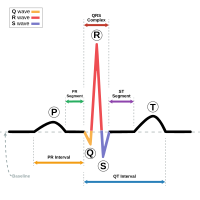
Photo from wikipedia
BACKGROUND AND OBJECTIVE Electrocardiogram (ECG) is an important diagnostic tool for the diagnosis of heart disorders. Useful features and well-designed classification method are crucial for automatic diagnosis. However, most of… Click to show full abstract
BACKGROUND AND OBJECTIVE Electrocardiogram (ECG) is an important diagnostic tool for the diagnosis of heart disorders. Useful features and well-designed classification method are crucial for automatic diagnosis. However, most of the contributions were in single lead or two-lead ECG signal and only features from single lead were used to classify the ECG beats. In this paper, a cascaded classification system is proposed to extract features and classify heartbeats in order to improve the performance of ECG beat classification via multi-lead ECG. METHODS In contrast with most of the literatures, ten signal features were chosen and run on each of the 12 leads separately. Based on these features, we developed a novel feature fusion method combining information from all available leads, and then implemented a cascaded classifier utilizing random forest (RF) and multilayer perceptron (MLP). Besides, in order to reduce the feature space dimension, principal component analysis (PCA) was applied in the method. MATERIALS Four open source databases including MIT-BIH Arrythmia Database, QT Database, MIT-BIH Supraventricular Arrhythmia Database and St. Petersburg Institute of Cardiological Technics 12-lead Arrhythmia Database (INCART Database) were used in this work. These four databases are different in classes of beats, volume of dataset, number of individual volunteers. Except INCART database, in which the recording format is 12-lead, the other three databases consist of 2-lead recordings. Above all, they all have annotations for every single beat including the type of each beat. CONCLUSIONS Extensive experimental results shown that the average accuracy achieved 99.3%, 99.8%, 97.6% and 99.6% on four databases respectively. Compared with most state-of-the-art methods, our work has better performance and strong generalization capability.
Journal Title: Computer methods and programs in biomedicine
Year Published: 2019
Link to full text (if available)
Share on Social Media: Sign Up to like & get
recommendations!